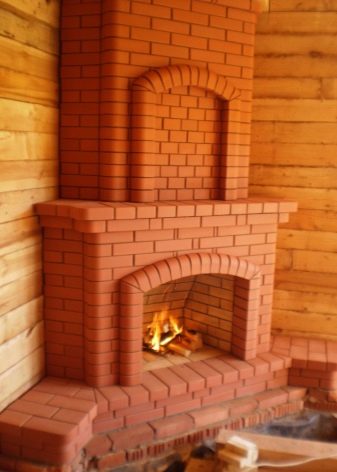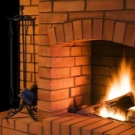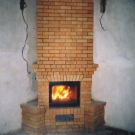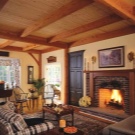Cleaning soot chimneys and fireplaces
People who have stoves or fireplaces at home are well aware that these devices require periodic cleaning. Even the most modern private heating system needs care at least once a year. Special companies are engaged in cleaning chimneys of stoves and fireplaces from soot in settlements. It is worth noting that this operation can be performed independently. It is only necessary to remember about safety and know about effective methods.
Some circumstances affect the amount of soot and the rate of pollution:
- Terms of use stoves and fireplaces.
- The design of the pipe and the heating device itself.
- The nature of the fuel.
- The quality of heating materials.
What is cleaning for?
Everyone knows that the burning of absolutely any type of fuel precipitate is released. This substance is called soot and it constantly accumulates on the pipes of the system. In addition, very often the installation suffers from accidentally falling into the pipe leaves, small stones,nests of birds and other things. Cleaning the chimneys of stoves and fireplaces from soot is necessarily necessary in order to avoid unpleasant consequences. Namely:
- A narrowed pipe for smoke extraction, which subsequently leads to a reduction in thrust.
- The rapid deterioration of the chimney.
- Reducing the performance of the boiler.
- The risk of fire in the pipe itself.
Thanks to cleaning the chimney at least once a year, such troubles will not be, and the heating device will delight with its excellent working functionality. It is worth noting that it is necessary to clean the pipes regardless of how they are arranged and where they go. That is, it is standard through the roof or with a side device through the wall.
How do you know when cleaning is really necessary, and when can it wait?
In fact, there are several signs of a critical state of the chimney. Firstly, it is a shade of smoke. Perfect smoke is white or light, but in any case translucent. But the dark, muddy smog says that it is necessary to take any action.
Secondly, the dark orange color of the fire in the stove or fireplace and claps mean problems in the chimney. Ideally, the flame should be bright and bright.
Which way to choose?
There are only four ways to clean a pipe. Which one of the most successful and suitable can be determined only by the owner of the heating device. Each cleaning method has its positive and negative points.
Folk way
The most popular and affordable means for cleaning the chimney is salt. Rock salt can be found in every home, and to do with it cleaning is easy. To do this, simply sprinkle seasoning on any fuel. But experts note that this tool acts more as a prevention of soot. Upgrade guaranteed pipe it can not.
In the second place in popularity are the potato tubers or its skin. The number of fruits depends on the volume of the stove or fireplace. On average, at least a standard bucket should go. They do exactly the same as with salt. Cleaning or the potatoes themselves spread on fuel when burning.
This folk remedy is explained by the fact that the starch extracted from the fruit, rising up, softens soot and other dirt. Then it all comes out of the pipe. But do not rely on this method of cleaning this time either.At the end of the operation, it is best to mechanically clean the chimney.
Firewood from aspen. This popular method is controversial and dangerous. The thing is that during the burning of aspen wood, the heating system itself and the chimney in particular is heated to the maximum possible temperature. The effect is that soot and other dirt burn out without a trace. But it should be remembered that this method is ideal only for high-quality and durable pipes, otherwise there is a high probability of destruction of the chimney.
Chemical method
To date, in specialized stores and departments you can find a huge number of different chemical means for cleaning chimneys. Most of the drugs are designed for independent work and do not require any skills and knowledge.
Chemicals can be either dry or liquid. In order to clean the chimney from the products of combustion and small debris, it is necessary to lay out the drug on the fuel and ignite. The principle of operation is based on the fact that at an elevated temperature a chemical agent emits special substances that destroy soot layers and it crumbles down. Do not be afraid that the substances are toxic.They are absolutely safe for the human body.
Mechanical method
This method does not require special financial costs, but is very time consuming and in some way dangerous. To clean the chimney yourself, you must first close all the holes in the stove or fireplace so that soot and dirt do not get on the floor, walls and furniture. On a ceramic fireplace, you can just hang a dense wet matter.
Climb to the roof. To clean the pipe, you should choose a good windless and not rainy weather, as well as use a rope or other safety device. Otherwise, there is a risk of dangerous injury.
Carefully inspect the pipe. If the soot layer is less than two millimeters, then mechanical cleaning should be postponed to a thicker coating and use folk remedies or chemicals.
If a large amount of dirt has accumulated in the pipe, then it is worth removing it or pushing it down. Soot for a start must be cleaned with a special scraper, and then with a brush to make progressive movements up and down. The width of the brush or brush should be slightly larger than the pipe size.
There is such a tool as a core for more complex clogs and contamination.This is a small heavy ball with a mount that must be gently inserted into the pipe or used as a weighting agent for brushes. It should be remembered that you can use a core that is only intended for cleaning pipes. All other household items can damage the chimney.
After all the manipulations, you can open the holes and remove the wet matter. Be sure to clean the hearth and firebox from plaque and dirt.
Fireplaces are convenient because they can be cleaned both from the roof and from below. All the necessary tools for this can be purchased at the respective stores.
"Log"
Quite a popular tool that relates to chemical methods of cleaning the chimney. It effectively acts both for systems with liquid fuel, and with solid. An intuitive instruction is always attached to it. The quantity and frequency of use always depends on how quickly soot accumulates on the chimney.
If it is a fireplace, which is usually lit in special cases a couple of times a week, or even two, then you need to use one package every six months. If this is a stove, which regularly heat the living space, then you will need one briquette every two months.Consider the size of heating systems. For large devices use twice as much money as for small or medium.
In order to clean the chimney, you need to put the "log" on the fuel directly in the package. Best of all if it is hot embers. The briquette should ignite and extract the active substances that will eliminate the soot. You should be careful and before all actions make sure that the passage is not clogged with debris. Experts say that the effect of "logs" can last up to two weeks.
Useful tips
In order for the heating system to serve longer and the pipes with the back of the stove or fireplace do not need to be cleaned, it is necessary to follow a few simple recommendations.
Do not incinerate plastic trash, polyethylene and paper. The chimney is best insulated with special material. This is especially important to do in the back.
Put the cap on the pipe, thereby protecting the chimney from debris and dirt. It is best to drown with hardwood, and only at the end of the kindling can you try to experiment with two types of trees.






































































